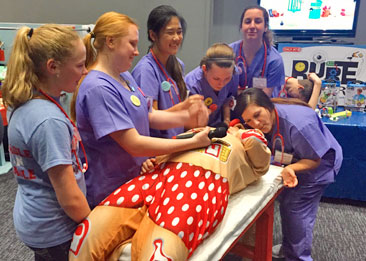Pick up a copy of the newspaper your local newsstand.
![]()
PAGE UPDATED BY MARIA SIEVERDING SEPTEMBER 12, 2017 10 A.M.
Engineering courses thrive in local schools
Jared Rogers
STAFF WRITER
What is engineering? Where can it take me?
These two questions intrigue students in Ripley County, especially since 2009. That was the year Project Lead the Way (PLTW) was implemented in local middle and high schools, and the focus on STEM (Science, Technology, Engineering, and Math) education began to grow.
 SUBMITTED PHOTO
SUBMITTED PHOTO
Engineering students at Jac-Cen-Del participate in the 2017 Rube Goldberg competition. They check on a patient for which they built a complex machine.
PLTW, a national program based regionally out of Indiana University-Purdue University Indianapolis (IUPUI), has a mission to prepare middle and high school students for today’s relevant career paths. Specifically, local educators saw the need to entice more students into engineering fields, thus creating a need for the program in our home schools.
Though courses offered at Jac-Cen-Del (JCD), Milan, and South Ripley now thrive; at first, local educators said, students didn’t know enough about them to make the effort to fit them into their schedules. The word has spread now, but an aspect of mystery within the courses still lives, and perhaps that is why they are popular.
“Students ask me to look up the answer to a problem in the ‘teacher’s manual,’” veteran instructor Paul Thole of JCD says, “And I tell them, ‘There is no manual!’” Likewise, textbooks are rarely relied upon. Engineering courses are heavily hands-on, creativity-based, and open-ended.
Anthony Moorman, Mr. Thole’s colleague at JCD, says this is what excites him about teaching PLTW engineering courses. “Students learn how to solve problems and think on their own. They are forced to think ‘outside of the box.’ They may not remember a formula, but they remember that they are able to intuitively work through problems to solve them.”
Mr. Thole agrees with Mr. Moorman’s assessment, and says it is that very process that first interested him in engineering, long before he even knew what to call it. “My dad was mechanically-inclined and I learned a lot from him. We used to fix farm equipment together, and it made me think I loved farming; but I was actually being an engineer.” Mr. Thole was able to impart the same curiosity towards problem solving to his son, who at age 16, found a niche in school by participating in the Rube Goldberg competition.
The annual, national competition, which started at Purdue University in the 1980’s, encourages students to solve a simple task by creating a complex, domino-effect contraption to do the work for them. In 2016, the simple task was to open an umbrella. In 2017, it was to apply a band-aid. JCD students placed fourth in the nation in 2016, and second in 2017, along with winning the coveted “Rube Goldberg Legacy Award,” bestowed by a descendent of the competition’s namesake creator.
Across the county, Milan teacher Jeremiah Loehmer also relishes the opportunity to incorporate intuition and creativity into his curriculum. Loehmer teaches PLTW’s second level course, “Principles of Engineering” to high school students; and he also brings engineering and design to students in grades 4-8 by incorporating relevant projects into his art classes. “Art flows with the STEM curriculum,” he says, and his fusion of those subjects has students as young as fifth grade drawing up house designs and floor plans. Students mimic a drafting table, just like a professional would use, and use graph paper to sketch. Eventually, Loehmer introduces architectural principles that include adding elevation into their designs.
For fourth graders, Loehmer teaches robotics thanks to a grant by the Ripley County Community Foundation (RCCF). “We spend most of the second half of the year building and programming robots,” Loehmer says of this art class. He strongly believes visual art and creativity go hand-in-hand with practical engineering principles. Milan middle schoolers continue their progression in STEM programming, learning about topics such as thermodynamics, gearing, and physics before transitioning into the level one PLTW engineering course, “Introduction to Engineering and Design,” taught by Milan teacher Jeff Stutler.
The PLTW courses progress as listed: Level one, Introduction to Engineering and Design; level two, Principles of Engineering; level three, Civil Engineering and Architecture; and level four, Digital Electronics. In conjunction with the level four class, students have the option to take additional PLTW engineering courses: Engineering Design and Development; Computer Integrated Manufacturing; and Aeronautical Engineering. These higher level courses are offered at JCD, taught by 45-year teaching whiz Paul Thole and the young and budding Anthony Moorman.
South Ripley teachers Matthew Gadberry, Wanda Ploeger, and Troy Mohr offer levels one through three in-house; and aforementioned teachers Mr. Loehmer and Mr. Stutler offer levels one and two at Milan. Students wishing to progress into the higher levels attend JCD. Currently, South Ripley has two students traveling for those classes, and last year Milan had two. In total, hundreds of local middle and high school students participate in the PLTW and STEM-based courses.
Rod Hite, principal of South Ripley High School, praises the work done by engineering teachers: “When you have teachers excited about their class material, it draws students in. The teachers drive the success of the program.” All three of the schools recognize the importance of their collaboration with the RCCF’s Genesis: Pathways to Success initiative, too, which promotes STEM education at the local level, in conjunction with participation in the national PLTW program.
So, what is engineering, and where can it take a local student? It seems that engineering is learning how to truly think and solve problems; not merely memorizing an answer and regurgitating it. Our society needs that: People who are creative enough to break through barriers; people willing to take risks and try something new.
To answer the second question, a thinker known as Dr. Suess once wrote, “Things may happen, and often do, to people as brainy and footsy as you.” For students willing to test their capacities, who knows where engineering may take them? Surely somewhere positive and impactful in our shared future.
Sepsis Awareness Month
King’s Daughters’ Health, in conjunction with the Indiana Patient Safety Center of the Indiana Hospital Association, is working to improve awareness and understanding of sepsis during national Sepsis Awareness Month in September.
 What is Sepsis?
What is Sepsis?
One of the first objectives is to answer this basic question. Often, sepsis is thought of as an infection that has spread throughout the body. In reality, sepsis is the body’s overwhelming and potentially life-threatening response to an infection that can cause the body to injure its own tissues, such as skin, muscle, heart, liver, lungs, or kidneys. Any type of infection can cause sepsis, even seemingly minor infections of the skin; so, it’s important to understand the potential warning signs of sepsis.
Locally, urinary tract infections and pneumonia (or other lung infections) tend to be the most common causes of sepsis. Those most at risk of developing sepsis are the young (under age 10) and the elderly (over age 65). Additional risk factors include a weakened immune system, having a Foley catheter or IV, and having a chronic illness such as diabetes, or kidney or liver disease. While symptoms of sepsis can include diarrhea, vomiting, and sore throat, it’s also common for someone with sepsis to display more serious, rapidly appearing symptoms, such as an elevated fever associated with shivering, chills, or feeling very cold; extreme pain or discomfort, or progressively feeling worse than ever; pale or discolored skin; rapid or difficulty breathing, compared to your normal rate; and sleepiness, confusion, or difficulty waking up.
If you or someone you know develops any of the above symptoms, contact your doctor right away or go to your nearest emergency room. Be sure to tell your doctor that you think you might have sepsis. Be honest about how you feel and do not dismiss or downplay symptoms. Early diagnosis and treatment are important.
To reduce the risk of sepsis, health professionals encourage patients of all ages to stay updated with their vaccinations, get a flu shot each year, clean scrapes and wounds, and practice good hand hygiene, such as hand-washing. If you have specific questions, talk to your doctor or healthcare provider.














